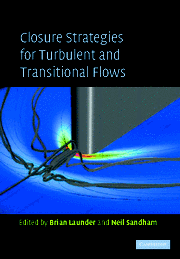20 - The Joint Scalar Probability Density Function Method
Published online by Cambridge University Press: 06 July 2010
Summary
Abstract
The purpose of this chapter is to review the joint probability density function, (PDF), evolution equation approach to calculating the properties of turbulent flames. In this approach the closure of the micromixing term represents a central difficulty and for this, various proposals including the linear mean square estimation closure, coalescence-dispersion models and Langevin, binomial, mapping and Euclidean minimum spanning tree closures are appraised. Results obtained with the PDF equation using a modified coalescencedispersion model and a simple global reaction mechanism demonstrate that the method is capable of reproducing measured mixture fraction, fuel and CO2 profiles in jet diffusion flames and counterflow premixed and partially premixed turbulent flames. The levels of carbon monoxide are somewhat overpredicted in all the flames considered but it is argued that this is primarily a consequence of limitations in the simplified chemical reaction mechanism used. The need for improved models to represent micromixing is also suggested.
Introduction
Calculation methods for predicting the properties of turbulent flames in practical combustion systems invariably involve statistical methods in which the partial differential conservation equations are averaged to yield transport equations for the moments of the appropriate dependent variables. Alternative approaches such as direct solution of the exact instantaneous forms of the equations (DNS) for turbulent flames are computationally prohibitively expensive for engineering applications. DNS is presently restricted to flow at low Reynolds numbers and in simple geometries and is likely to remain so for the foreseeable future. Large Eddy Simulation (LES), although becoming a viable tool for engineering applications, does not alleviate the problems arising from combustion. In the case of LES, burning is likely to occur predominately within the unresolved sub-grid scales and the resulting closure problems are then similar to those arising in conventional moment closures.
In moment closures, averaging leads to a loss of information with the consequent appearance of various unknown terms, dependent on the fluctuating turbulence field, and closure approximations are needed to represent them. In turbulent flames the processes for which closure approximations are required include turbulent transport (diffusion) of heat, mass and momentum and turbulence-chemistry interactions. For turbulent transport a turbulence model is required but it is the turbulence-chemistry interactions which represent the central difficulty in turbulent flames. More specifically, in moment closures a means must be available to evaluate the averaged net formation rates which appear in the transport equations for the mass fraction of each chemical species present.
- Type
- Chapter
- Information
- Closure Strategies for Turbulent and Transitional Flows , pp. 582 - 625Publisher: Cambridge University PressPrint publication year: 2002
- 4
- Cited by



